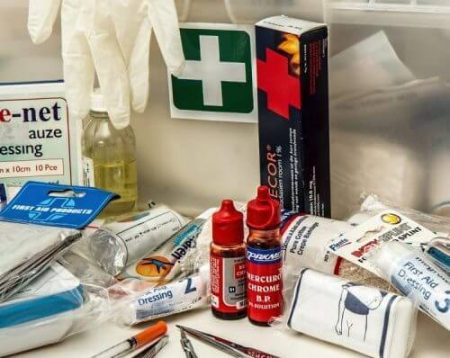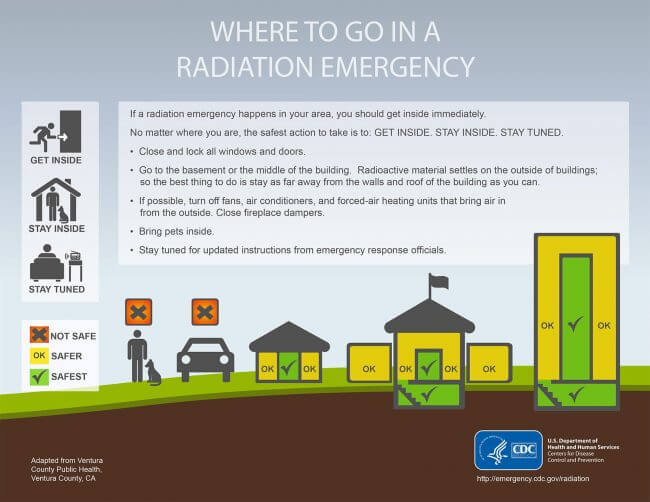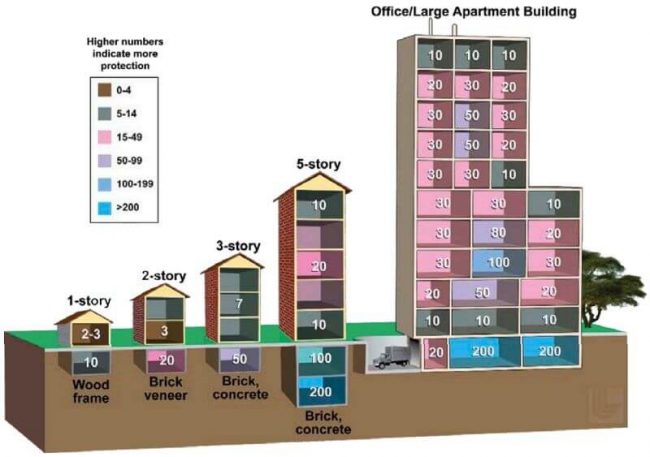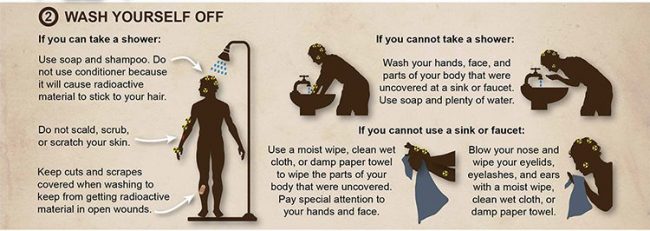Since nuclear weapons (aka nukes, bombs, atomic bombs) were first used during WWII, the world has been asking itself how to survive a nuclear attack. With nuclear threats popping up worldwide, Google searches for how to survive a nuclear attack are rising.
Surviving a nuclear attack requires initial planning, preparation of your home before the attack, understanding what to expect during the attack, and knowing how to recover after the attack. Once you have a solid grasp of these topics, your chance of survival greatly increases.
Initial Planning
Have a plan before there is a threat.
Everything starts with planning. If you’re already of a preparedness mindset, you’re most likely well on your way. If you aren’t already getting prepared, it’s never too late! Taking action today could save you and your family in a nuclear attack or even a full-scale nuclear war.
Your plan will mostly revolve around the storage of food, water, medical supplies, etc. These will allow you to spend several days indoors and sealed up away from the radiation outside.
This plan should also include choosing a room in your house to use as a shelter-in-place room. This room should be the area that provides the most shielding from radiation for you and your family. Families with a designated shelter-in-place room are much more likely to survive.
Choose where you live based on likely targets.
To drastically increase the likelihood of surviving a nuclear attack, live away from areas that provide targets of opportunity or strategic value. These areas include strategic missile sites and military bases, government centers like Washington, DC, capitals, transportation hubs, and communication centers.
Manufacturing, industrial, technology, and financial centers, as well as refineries, power plants, and chemical plants, are also targets of value.
Store food that will not go bad.
Long-term food storage is the backbone of most good preparedness plans. Foods like rice, beans, honey, powdered milk, wheat, sugar, oats, and pasta are all great ways to begin storing food.
You can get a good head start on your food storage by buying in bulk. For instance, a 50 lb bag of rice costs roughly $15-20 and has almost 30,000 calories. A 20 lb bag of pinto beans will cost you about the same and has a little more than 30,000 calories. For $30-40, you can start with enough food for a family of four for a full week! You could stretch it out even further if you needed to.
Make sure you include food for any pets.
Store water for you and your family.
One gallon of water per day, per person, is a good rule of thumb. Normal tap water will last long without needing any treatment as long as it’s kept from sunlight and stored at room temperature. This prevents algae from growing in the container.
Ensure that your pets have water as well. How much water they need will depend on how large they are.
Don’t forget to read about how to filter water after a nuclear attack!
Have a means of communication available.
You’ll want a hand-crank radio available if you get one that monitors the NOAA emergency channel; even better! This will let you listen to emergency broadcasts that hopefully provide updates about the attack.
Keep your cell phone with you. I’d suggest turning it off to preserve the battery and turning it on every so often to see if you have a signal.

Keep enough medical supplies to treat common injuries.
I would suggest having a basic first aid kit at a minimum. This should have basic bandages, antibiotic ointment, rubber gloves, etc. You’re going to want to be able to treat cuts and other minor wounds with this kit.
If you want to be even more prepared, you’ll need to have items that let you treat injuries that could be common following a nuclear attack. SAM Splints would be great to immobilize any broken bones or serious sprains caused by falling debris from the initial detonation.
Lacerations from flying glass and debris can also occur. A few tourniquets, bandages, and quick clot-impregnated gauze will allow you to treat severe bleeding.
Radiation burns will be common depending on your distance from the initial blast. Minor radiation burns (like sunburn) can be cleaned and covered with Vaseline to prevent cracking.
Cover them with a sterile wrap if they begin to char and blister. More severe burns will need to be treated more carefully.
Cut away clothing around the burned area and wash the area with water only. If you’ve stored some burn dressings (you probably should), apply them to the burned area. If you don’t have a burn-specific dressing, you can cover it with plastic wrap or anything else that will not stick to the burn.
Have a way to keep yourself clean.
This isn’t the difference between life and death after just a few days, but it will make you more comfortable and make being sealed in a room with your entire family more bearable.
Baby wipes, deodorant, a toothbrush, and toothpaste can help you not only smell better but also help you feel more normal and comfortable. It can go a long way to aid your mental well-being.
You’re going to need to go to the bathroom.
A 5-gallon bucket, heavy-duty garbage bags, and cat litter make a great makeshift toilet. Line the bucket with the garbage bag, put some kitty litter in the bottom and go to the bathroom. When you’re done, cover your waste with some more kitty litter. When the smell gets too bad, tie the bag up and replace it with a fresh one.
Build a shelter-in-place kit.
A shelter-in-place (SIP) kit will allow you to seal your SIP room from dangerous radioactive fallout. (This same kit can protect you from the effects of a chemical spill or chemical or biological weapons attack.)
The kit should include plastic sheeting or heavy gauge trash bags, duct tape, flashlights, a light source (candles, hand crank lights, etc.), dust masks, rubber gloves, and tools needed to turn off utilities.
A pry bar or metal-handled survival axe could be good if you move rubble or other debris.
If you already have a bug-out bag, you could always keep it in your SIP room and use it as a base for your shelter-in-place supplies. Another good place to look is premade survival kits to give you a solid starting point.
Follow these steps to protect your home.
Immediately get inside, seal your house and SIP room, and await further instructions.
When you see a nuclear detonation or are notified in some way, do the following to ensure you’ve sealed your home and shelter-in-place room as best as possible.
- Close and lock all windows and exterior doors.
- Shut down any furnaces, air conditioners, exhaust fans, and vents.
- Close the fireplace damper.
- Gather any pets and head to your designated shelter in the place room.
- Cover all vents, windows, and doors using plastic sheeting or heavy trash bags and duct tape.
- Once you’re sealed in your SIP room, you should stay in place until you hear an “all clear” on your radio or you are forced to leave.
Expect additional attacks to follow. They may come from more nuclear attacks or conventional forces, missiles, and aircraft.
If the attack was part of the early stages of a nuclear war, then you can expect follow-on forces. If the attack was the act of a rogue state or terror group, then follow-on attacks may not be likely.
What Happens During an Attack?
In the event of a nuclear war, many more nukes would be detonating in other large cities. This would significantly increase the amount of nuclear fallout experienced across the nation.
Understand how to protect yourself.
Before discussing what happens in a nuclear attack, we should probably discuss the factors that keep you safe from radiation. It all comes down to three things, shielding, time, and distance.
Shielding will physically block the radiation from coming in contact with you. Some forms of radiation can be blocked by something as thin as your skin.
We want to block the high-energy radiation that will penetrate most items. We need thick, dense materials to block this type of radiation (x-rays, gamma radiation, etc.). There are things like earth, concrete, lead, and water.
Time refers to the length of time that you’re exposed to radiation. The less exposure, the better.
Finally, we have distance. By putting distance between you and the contaminated area, you’re decreasing the radiation that can reach you.
The initial detonation.
It would be devastating if a nuclear weapon were to strike the US without warning. With the most likely threat being a nuke from North Korea, we’re going to look at a scenario using one of their 10-kiloton weapons.
Any of us within a mile of the blast from one of these weapons would likely be dead. The detonation would level most buildings to .94 miles, and anyone unprotected would suffer 3rd-degree burns with a 100% probability. Up to 3 miles out, the windows of buildings will be blown out, sending glass shards flying.
If you happen to be near a window and see the blast, get away from the window right away and try to get undercover. You only have about 10-15 seconds before the blast wave makes it to you, smashes the windows, and throws things around.
Before the fallout touches down.
Surviving a nuclear attack goes beyond just surviving the initial blast; we would still only have 10-15 minutes to get to shelter before the radioactive fallout starts making it to the ground. Fallout is the small particles of radioactive dust and debris the explosion threw into the atmosphere.
For those of us that make it to cover before the fallout makes it to the ground, it’s best to try to get into a building with thick concrete walls, underground facilities like a subway or parking garage, or the basement of an apartment building. The fallout will land on the rooftop, so the closer you get to the ground floor, the better.

This infographic from FEMA goes more in-depth in its coverage of how buildings can shield you. Numbers represent a dose reduction factor. A dose reduction factor of 10 indicates that a person in that area would receive 1/10th of a person’s dose in the open. A dose reduction factor of 200 indicates that a person in that area would receive 1/200th of the dose of a person out in the open.

After the fallout begins to land.
Getting stuck outside once the fallout begins to land will leave you in a bad spot. It would be best if you tried to cover your mouth and nose with a cloth or article of clothing. Any contaminated particulates you breathe in will get lodged in your lungs and nose, continuously radiating you from the inside out.
It’s hard to figure out how much radiation you may have absorbed by this point. If you begin vomiting from the radiation, that’s a sure sign of severe radiation poisoning. Even if you survive, the chances of long-term cancers like leukemia are very high. Prussian blue will decrease the level of radiation in your body if you find some.
Prussian blue reduces the biological half-life of cesium from 110 days to around 30 days and the biological half-life of thallium from 8 days to about three days. This doesn’t mean that the radiation doesn’t affect you, but it could give you a chance of making it.
Unfortunately, Prussian blue is not readily available, and no programs are currently in place to distribute it to the public.
Learn how a gas mask can protect you from nuclear fallout!
Inside your makeshift bunker.
Try to spend at least 48 hours indoors if you can. This will give the fallout time to lose a lot of its energy. It’ll still be dangerous, but it’ll be much less dangerous than it was two days earlier.
Basic Decontamination Skills

Most people who have been in the military have gone through some decontamination line either during an exercise or for real-world purposes. To survive after a nuclear attack, decon skills are key to limiting the amount of time you spend exposed to nuclear fallout.
There is no magic way to get be completely free of residual contamination. Still, you can greatly limit the amount of contamination by following the simple steps below.

The first part of decontaminating yourself is to remove your clothing. This removes the dirtiest layer and allows you to separate it from yourself and others.
Asking strangers to get naked may be a problem! Explain to them that it’s a life and death situation and don’t let them inside until they dispose of their clothing.

The main point to take away from here is the cover cuts, scrapes, and wounds, so you don’t wash any material into them. Even the wounded need to be fully deconned!

I would highly suggest trying to find clean clothing or only putting back on items with the lowest possibility of contamination. Shaking them out may get a lot of the contamination off, but it isn’t something I’d bet my life on!

When you get to help others, you need to ensure that you allow as little contamination back on you as possible. Then, clean yourself again as soon as well as you can.
It doesn’t do you any good to decon yourself, then someone else, only to get contaminated and not clean yourself a final time. Minimizing the spread of contamination will have to become a part of your life if you want to learn about surviving a nuclear attack.
Conclusion
Have we survived the attack? Well, that depends.
We’re almost definitely dead if we were within a mile of ground zero.
If we were within three miles of ground zero, we’re still most likely dead or dying. This changes if we were within some structure that prevents the radiation from getting to us and protects us from the fallout. We still need to wait the next 48 hours with little to no supplies, but we’re in better shape than many people.
Anyone lucky enough to be at home and prepared will probably survive a nuclear attack pretty well.
Ultimately, a nuclear attack is survivable as long as you aren’t right in the initial blast area. So be prepared, stay calm, and hope for the best!

